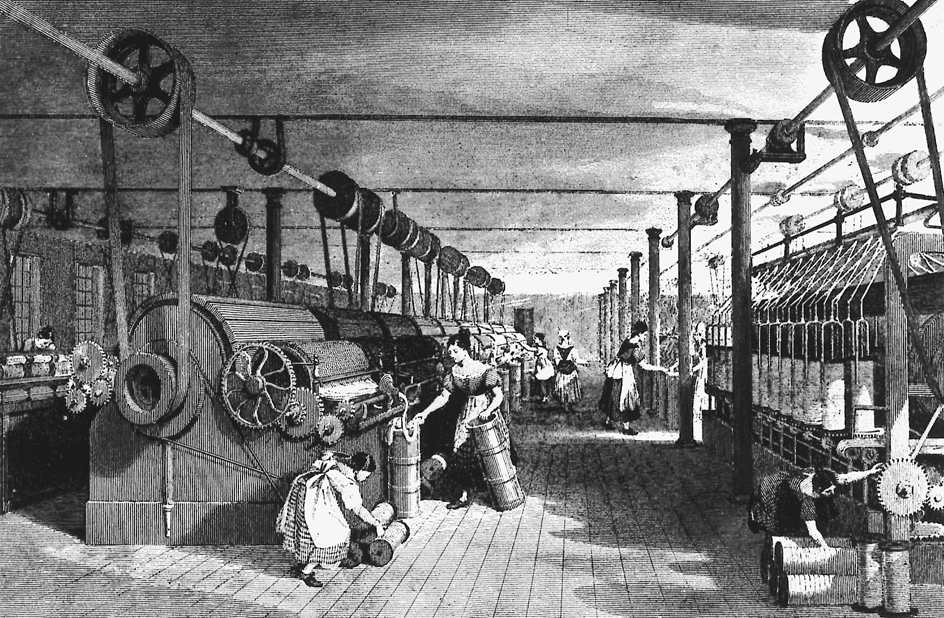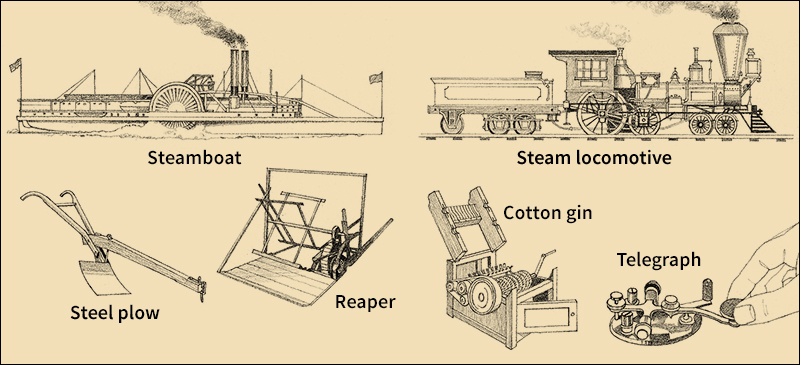Technology refers to the inventions—including tools, techniques, and processes—that people make and use to survive and prosper. Technology has made it much easier for people to satisfy their needs and desires. It has also helped make people more productive and freed individuals to explore such endeavors as art and science without having to worry about simple survival.
Technology and science are closely related, and each contributes to the other. Science attempts to gain knowledge about natural occurrences by making observations and collecting facts. Technology sometimes uses scientific methods and knowledge. But much of technology is not based on science, nor is understanding science necessary to all of technology. For example, people made bronze by mixing copper and tin long before they learned how the metals actually combine to form it.
This article describes some of the ways in which technology has influenced the development of society. It also discusses challenges people face in using technology effectively. The history of technology largely parallels the history of invention, traced in the article on Invention. Information on the development of specific technologies can be found in the History sections of such articles as Agriculture, Communication, and Medicine.
History of technology
The term technology includes primitive tools and methods of work as well as highly advanced ones. For example, a person using a sharpened stick to dig up roots to eat is using a primitive form of technology. Therefore, we could say that human beings have lived in a technological society since prehistoric times. When people speak of technology today, however, they usually mean high technology—the most advanced and sophisticated kinds of electronics and other modern technology that currently exist.
Primitive technology.
The first technologies were tools used by animals to get food. Chimpanzees, orangutans, and such birds as crows have been observed making such tools out of sticks and stones in the wild. The ancestors of modern human beings used simple tools that they made from wood, stone, or animal bones. About 600,000 years ago, prehistoric people discovered how to make fire.

Agriculture and civilization.
Around 8000 B.C., people in several areas of the world developed agriculture. They discovered that certain food plants could be planted and harvested year after year. The development of agriculture enabled people to settle in one place. Eventually, they could grow enough food for larger populations, forming towns and cities. Under the conditions of settled life, people could do other jobs not related to food production. Some of them became warriors, priests, craftworkers, and merchants. This development is known as division of labor.

Human and animal labor was then the chief source of mechanical power. But people gradually realized that wind, water, gravity, and other natural sources of power could be used to do physical work. By the 2000’s B.C., people had begun to construct irrigation canals to bring water where it was needed and to build ships with sails to harness wind power. At the start of the Iron Age, about 1500 B.C., people learned to make more durable tools, weapons, and other items out of iron.
Technological advances
were carried throughout the world by traders and other travelers. For example, the traders who brought silk and spices to Europe from China also brought technological ideas, such as gunpowder. The Chinese invented gunpowder before A.D. 900, and it was brought to Europe around 1250 by travelers who saw it being used in the East.
The Chinese began using block printing to produce copies of religious texts about the A.D. 600’s. This technique was introduced to Europe in the 1300’s. But books were not published in great numbers in Europe until the introduction of printing presses that used movable type. These presses were developed in Europe in the mid-1400’s. Over the next 200 years, books became widely available and affordable throughout most of Europe. More and more people learned to read. In the 1500’s, books from around the world were translated into different languages. People could then read about ideas from other countries and continents.

The Industrial Revolution
was a period of rapid technological innovation that began in Britain in the 1700’s and spread to continental Europe and America in the middle to late 1800’s. It brought tremendous change to the way people lived and worked. This period featured the extensive use of water power, the development of steam engines, the use of coal as a fuel, and the growth of factories. Later in the period, inventors and engineers developed electrical machinery, the internal-combustion engine, and large-scale chemical processes. See Industrial Revolution.

The first factories were built by textile manufacturers. Before factories, individuals worked at home to spin thread and weave it into cloth. Beginning in the 1700’s, several new kinds of spinning and weaving machines were created. Textile producers realized that several of these machines could be powered by a single source by connecting them all to a water wheel or steam engine.
In the early 1800’s, the United States army sought weapons that could easily be repaired on the battlefield. In response, several gunmakers—including Eli Whitney, Simeon North, and Samuel Colt—developed techniques for making firearms with interchangeable parts. Repairs became much easier, because a broken part could simply be switched out with an identical replacement. To efficiently create interchangeable parts, manufacturers developed assembly lines and special purpose machine tools. People soon began making watches, sewing machines, harvesters, and bicycles with interchangeable parts. Beginning in the early 1900’s, the automaker Henry Ford used interchangeable parts with a moving assembly line to produce automobiles. Such mass production made it possible for many items to be made more quickly and cheaply.
By the mid-1800’s, the Industrial Revolution had caused people in Europe and America to abandon centuries-old ways of life. Numerous people moved away from rural areas to the cities, where they hoped to find work in factories. Cities grew and became more crowded. New roads, canals, and railroads were built to carry raw materials to factories and transport finished products to customers around the world.

The use of electricity.
Beginning in the late 1800’s and early 1900’s, scientific discoveries about the nature of electricity and electromagnetic waves led to a series of technological advances. One major development was the creation of alternating-current systems, which enabled power to be generated at one location—such as a waterfall or coal-fired plant—and then transmitted to distant factories and homes for running lights and motors.
Electricity also improved communication. Just as the printing press had done centuries before, the invention of the telegraph and the telephone brought about major social changes. For the first time, people could communicate with one another almost instantly across great distances. Later, the broadcasting of radio and television signals revolutionized mass communication by making it possible for people almost anywhere in the world to receive sound and pictures.

The computer age.
In the 1940’s, the first electronic computers were built to solve complex mathematical problems for scientists and for the governments of the United States and the United Kingdom. These early machines could perform a few thousand calculations per second. They were so big that it took a large room to house each of them. 
In the late 1940’s, engineers and scientists developed the transistor, a tiny device that controls the flow of electric current in electronic equipment. In the 1960’s, the development of the integrated circuit enabled manufacturers to put thousands of tiny transistors and other parts on a computer chip made of silicon. Integrated circuits could also be built to operate as tiny computers called microprocessors. These and other innovations have helped to make computers and other electronic devices smaller, lighter, faster, and less expensive.
The integrated circuit played an important part in space exploration during the 1960’s. Small, lightweight computers could more easily be loaded onto rockets and satellites and launched into space. Rockets lifted satellites into orbit to help with communications, scientific study, and military tasks. Spacecraft carried people to the moon, and remotely controlled probes explored other planets in the solar system. As computers became less expensive, businesses and universities began to use them more.
Toward the end of the 1960’s, the U.S. government linked computers between research laboratories using existing telephone lines, so that information could be transferred between them. In the 1970’s and 1980’s, some universities and businesses worked together to establish their own computer networks. Soon there were thousands of such networks. In the late 1980’s, computer scientists joined these networks together to form the internet.
Computers eventually became so inexpensive that families and individuals could afford them. Today, millions of people use them at work and at home. During the 1990’s, high-speed fiber-optic cables began replacing copper cables in telephone networks that linked computers on the internet. Fiber optics, which use light to transmit large amounts of data, allowed for highly complex websites to become practical. The internet has become a central means for economic activity, entertainment, and communication around the world.
Many things that people use in everyday life have simple computers that help them function. For example, many automobiles are built with an antilock braking system, in which a microprocessor adjusts the individual braking force of each wheel to prevent skidding.
Emerging technologies
today include not only electronics, but also biotechnology and nuclear energy. Biotechnology involves both the use of technology to solve medical problems and the use of biological science to aid in industrial processes. Recent advances in genetic research have changed the ways in which people fight disease and hunger. The manipulation of the chemical information contained in cells has resulted in the creation of bacteria that make insulin and plastics and of plants that are more resistant to disease and yield larger amounts of food. 
Scientific research into the structure of atoms has led to the creation of nuclear power plants. In the field of medicine, such research has led to the use of radiation to fight cancer. It has also resulted in the development of X rays and other methods of examining structures inside the body without surgery.
Transhumanism is the belief that human beings can eventually surpass the limits of the mind and body, through the advancement of science and technology. Development in such fields as biotechnology, nanotechnology (the creation and study of structures on the scale of atoms and molecules), and artificial intelligence is believed to hold great potential for increasing human capabilities and improving the quality of life. Transhumanists predict, for example, that medical advancements will improve the human body and drastically prolong life expectancy. Some believe that technological enhancement will boost human intelligence and ability. The idea of a transhuman future grew in popularity after the British biologist Sir Julian Huxley coined the term in his 1957 essay, Transhumanism.
Technology and society
People develop particular technologies to fit their needs and desires. People also influence how technologies evolve once they are developed. For example, the inventors and businessmen who designed the early telephone systems intended the telephone, like the earlier telegraph, to be used for business messages, not personal conversation. But people liked using the telephone to talk to friends and relatives. Telephone systems were eventually modified to reflect what people wanted.
Just as people influence how technology develops, it influences the way people live. Most technologies have benefits, but technologies also create new problems.
Benefits of technology.
The control over nature brought by technology has helped many people, especially those living in industrial nations. The use of tractors, chemical fertilizers, pesticides, and new plant breeds has increased food production all over the world. Transportation systems and refrigeration technology enable people in developed countries to enjoy a variety of foods, ranging from fruit grown in the tropics to fish caught near the Arctic Circle.
It was once unusual for people to travel more than a few miles from where they were born. The development of trains, automobiles, and airplanes enables people to travel far from their place of birth for both business and pleasure. New communication technologies, such as satellites, television, and the internet, allow people to see and hear things thousands of miles away without ever leaving their homes.
Once, people had few personal possessions. Mass production enabled manufacturers to produce items far more than cheaply than they could by hand. As a result, people in many industrial countries today possess far more clothes, furniture, and gadgets than did previous generations. To encourage people to consume more goods and keep the factories running, manufacturers rely on advertising to stimulate demand.
People who lived in cities before 1900 frequently became sick because they did not have ways to get clean water or dispose of their wastes. Today, in the developed world, water supply systems provide clean, germ-free water to every home, and sewerage systems collect and purify wastes. Technology has made city life more comfortable and freer from disease.
Challenges of technology.
Many technological developments that benefit society are accompanied by harmful effects. Such products of technology as motor vehicle emissions, industrial waste, and chemical pesticides have damaging effects on people, animals, and plants. The majority of industrial countries face problems of air, water, soil, and noise pollution.
Many people welcomed the automobile as a machine that would be cleaner than the horses it would replace. But eventually, millions of people began to drive automobiles. In large cities, traffic noise, automobile exhaust gases, and severe traffic congestion became common problems by the 1950’s.
The atomic bomb, developed by U.S. scientists during World War II (1939-1945), helped to end the war quickly. Today, several nations possess nuclear weapons thousands of times more powerful than those used in World War II. A war involving these weapons would cause severe large-scale damage to the earth. New chemical and biological weapons that have become part of the world’s arsenals also pose grave threats. Apart from their use in warfare, such weapons could also fall into the hands of terrorists if they are not properly secured.
The use of electrically powered machinery in industrial countries has greatly increased factory production. But at the same time, it has reduced the world’s supply of oil and other fossil fuels, which are burned to produce most of the world’s electric power. These fuels cannot be replaced after they are used. Moreover, the burning of fossil fuels contributes to global warming—an observed rise in Earth’s average temperature—as well as acid rain, which destroys forests and kills fish.
New technologies are constantly changing the way people do their jobs. Advances in technology often result in the elimination of jobs as machines replace human labor. But new technologies also create new jobs, such as those in the electronics industry.
While transhumanism predicts many technological benefits to humanity, it also presents new challenges and concerns. If people in the future live much longer than they do now, overpopulation could become a severe problem. Enhanced mental abilities could be dangerous if used for selfish purposes. Greater use of genetic engineering could lead to health and environmental hazards or new ethical problems.
Using technology safely.
Industries can help control environmental pollution by developing substitute technologies to replace those that produce harmful effects. For example, electric power companies have introduced equipment that enables them to burn coal more efficiently and with less pollution. They are also making greater use of renewable energy sources, such as solar, wind, and water power. Manufacturers can help conserve mineral and timber supplies by recycling materials left over from production processes, such as paper and metal scrap.
Developing a substitute technology can be costly. An industry may need to hire technology experts or invest in expensive new equipment. Most industries pay for these added costs by raising prices, which may hurt their business or affect consumers. In cases that affect the well-being of whole communities, states, or countries, government agencies may require industries to develop or use substitute technologies. For example, many state and local governments require factories to use pollution-control devices.
Along with their benefits, substitute technologies can also have undesirable effects. For example, nuclear power plants can produce tremendous amounts of electric power using only small amounts of uranium. And they do not pollute the air as do fuel-burning plants. Nuclear plants, however, leave behind dangerous radioactive waste that must be disposed of carefully.
Some experts urge that any proposed large-scale technology be thoroughly tested and then evaluated before it is put into use. Such an evaluation is called a technology assessment. Its purpose is to discover in advance the possible effects that a new technology may have so that governments can act to minimize its harmful effects and maximize its benefits.
Sharing the benefits of technology
is one of today’s major challenges. The less developed nations of the world enjoy few benefits of modern technology. But people living in these countries want many of the goods and services that technology has made available to developed nations.
New technology often changes a country’s economy, requiring workers to develop new job skills to remain competitive. New technology also can change political and social values. Without an awareness of such changes, the introduction of technology may create social problems and endanger the quality of life.
